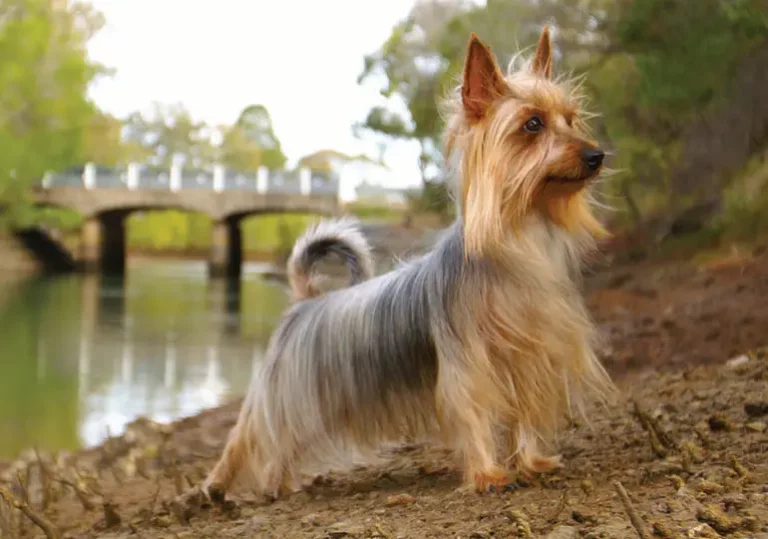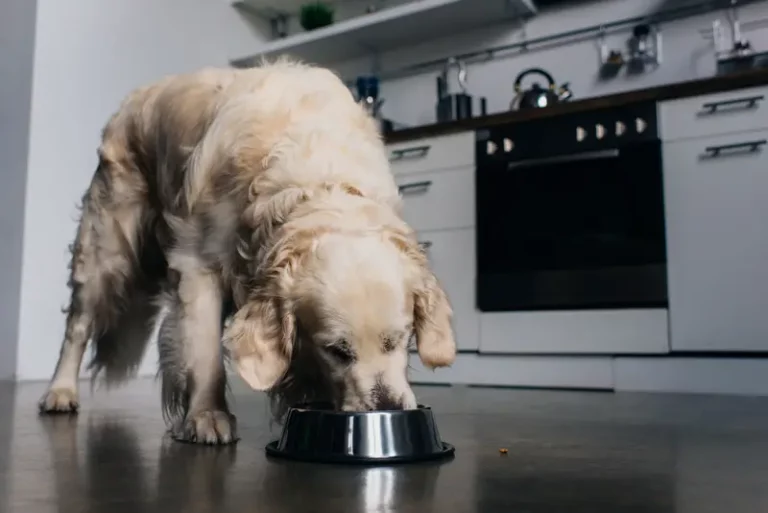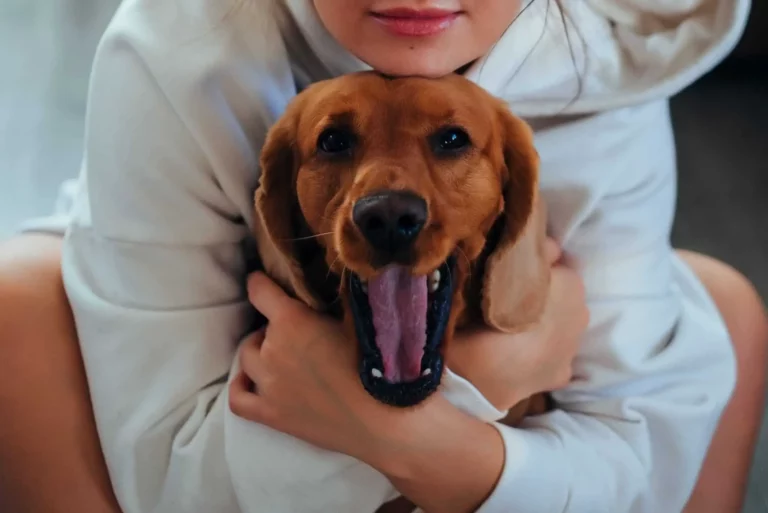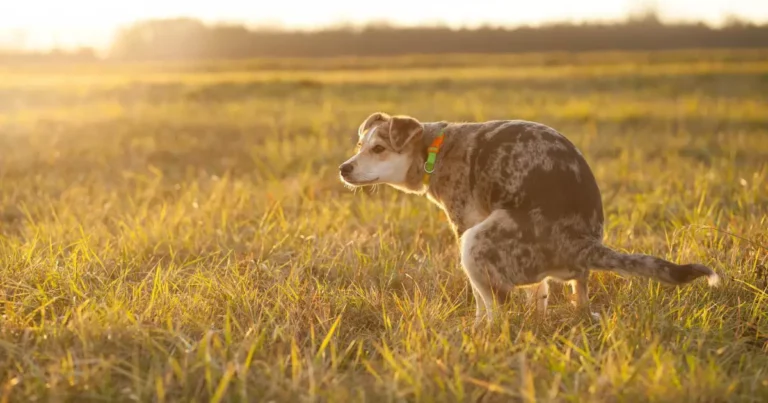Why Are My Dog’s Nipples Sagging? 4 Common Causes & Care Guide
Welcome, fellow dog owners! Have you ever noticed that your dog’s nipples are sagging and wondered if this is something to be concerned about? You’re not alone! Sagging nipples in dogs are not uncommon, and there are a variety of reasons why this might be happening.
In this comprehensive guide, we will delve into the common causes of sagging nipples in dogs, as well as the best ways to care for your furry friend during this time.
Rest assured, by the end of this post, you’ll have a better understanding of why your dog’s nipples may be sagging and what steps to take to ensure their overall health and comfort. So, let’s dive in and explore this topic together!
Understanding Your Dog’s Nipple Anatomy
Before we delve into the causes of sagging nipples in dogs, it’s essential to have a basic understanding of your dog’s nipple anatomy. This knowledge will not only help you better comprehend the potential reasons for sagging nipples but also assist you in identifying any changes or abnormalities.
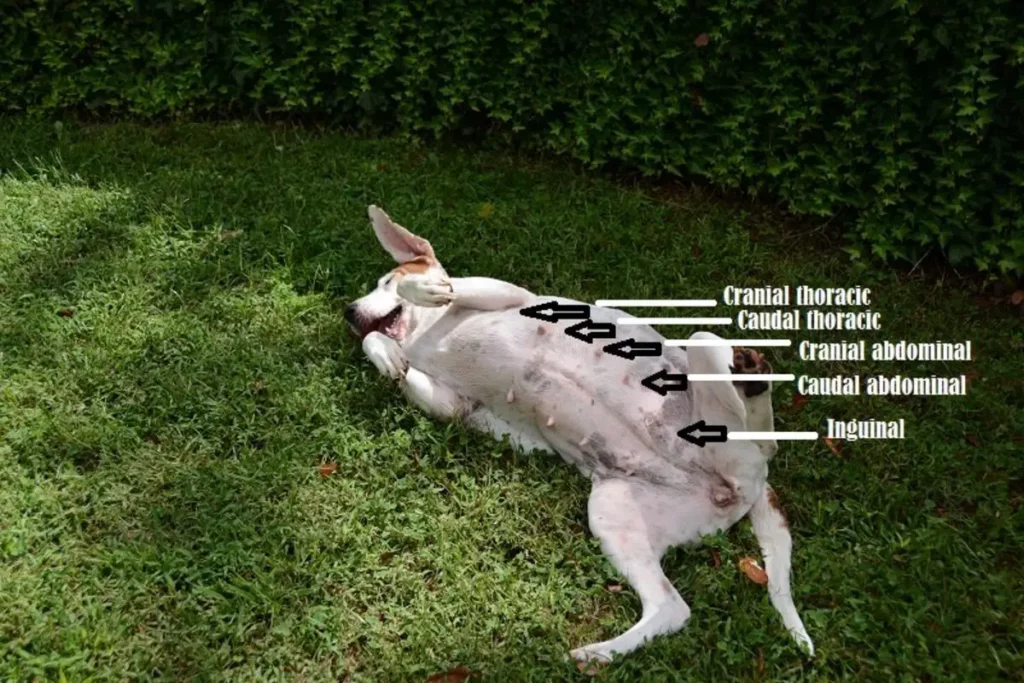
Number and Location of Nipples
Dogs typically have eight to ten nipples, arranged in two parallel rows along the underside of their torso. The exact number of nipples may vary from one dog to another, and in some cases, a dog might even have an odd number of nipples.
Nipple Structure
Each nipple is surrounded by a circular area of pigmented skin called the areola. The size, shape, and color of nipples and areolae may differ depending on the breed, age, and individual characteristics of your dog. It is worth noting that nipples serve as milk delivery channels for nursing puppies in female dogs, while male dogs have nipples that are mostly vestigial and serve no significant purpose.
Nipples in Male and Female Dogs
Both male and female dogs have nipples, though they may appear more prominent in females, especially those who have experienced pregnancy and lactation. The appearance and prominence of nipples may change due to various factors such as hormonal fluctuations, age, and overall health.
Now that you have a better understanding of your dog’s nipple anatomy, let’s explore the common causes of sagging nipples and how to care for them properly.
4 Common Causes of Sagging Nipples in Dogs
There are several reasons why your dog’s nipples may be sagging. Understanding these causes will help you determine if any intervention is necessary and what steps to take in caring for your furry friend.
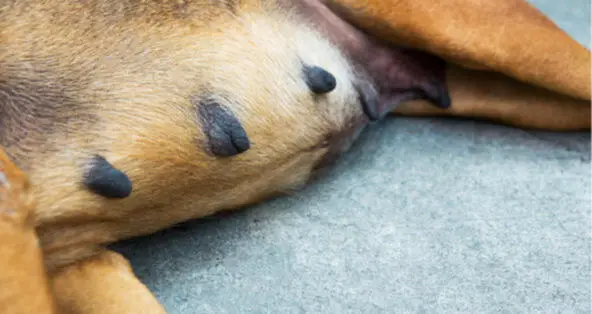
1. Pregnancy and Lactation
Pregnancy brings about various hormonal changes in female dogs, leading to the enlargement and sagging of their nipples as their bodies prepare for lactation. After giving birth, the nipples become even more prominent as the mammary glands produce milk for the puppies. Once the nursing period is over, the nipples may not return to their original size and may continue to appear saggy.
2. Pseudopregnancy (False Pregnancy)
Pseudopregnancy, also known as false pregnancy, occurs when a female dog experiences hormonal imbalances that mimic pregnancy, even though she is not pregnant. This can cause her nipples to enlarge and sag, similar to what happens during actual pregnancy. Pseudopregnancy typically resolves on its own within a few weeks, and the nipples may return to their normal size.
3. Age and Weight Changes
As dogs age, their bodies naturally undergo various changes, including the sagging of nipples. Older dogs may experience a loss of skin elasticity and muscle tone, causing their nipples to appear droopier. Additionally, significant weight loss or gain can also affect the appearance of a dog’s nipples. Weight gain may lead to stretched and sagging skin around the nipples, while weight loss can leave behind excess skin that causes the nipples to sag.
4. Infections or Inflammations
In some cases, sagging nipples can be a result of an infection or inflammation in the mammary glands. Conditions such as mastitis (infection of the mammary glands) or mammary gland tumors can cause the nipples to become swollen, red, and saggy. If you suspect that your dog is suffering from an infection or inflammation, it is essential to consult a veterinarian for proper diagnosis and treatment.
Now that you’re familiar with the common causes of sagging nipples in dogs, let’s discuss the accompanying symptoms that may indicate a more serious issue and the steps you can take to care for your dog’s sagging nipples.
Identifying Other Symptoms to Watch Out For
While sagging nipples can sometimes be a normal occurrence, it’s essential to be vigilant for any additional symptoms that may indicate a more serious issue. Keep an eye out for the following signs, and consult a veterinarian if you observe any of these symptoms alongside sagging nipples:
1. Swelling, Redness, or Discharge: If your dog’s nipples are not only sagging but also swollen, red, or have unusual discharge, this could indicate an infection or inflammation, such as mastitis. These symptoms should not be ignored, as prompt veterinary attention is required to treat the underlying issue and prevent complications.
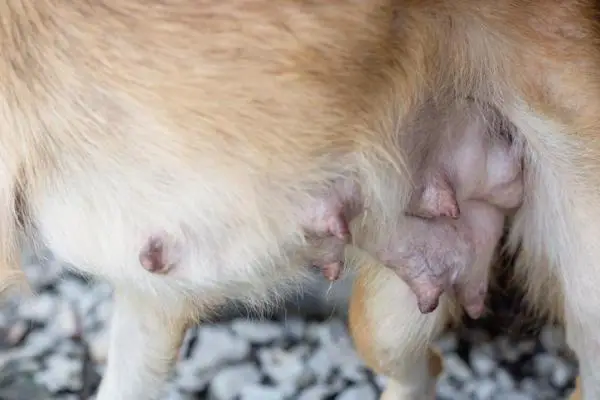
2. Lumps or Masses: Feeling any lumps or masses near or around your dog’s nipples could signify the presence of a mammary gland tumor or another abnormal growth. It is crucial to consult a veterinarian for a thorough examination and diagnosis, as early detection and treatment are vital in these cases.
3. Pain or Sensitivity: If your dog shows signs of discomfort or pain when you touch their sagging nipples, it may be due to an infection, inflammation, or another medical issue. Consult your veterinarian for a proper assessment and treatment plan.
4. Changes in Behavior: If you notice changes in your dog’s behavior, such as lethargy, loss of appetite, or increased aggression, this could be a sign of an underlying health problem. It’s essential to monitor your dog’s overall behavior and seek veterinary advice if you observe any concerning changes.
Now that you know what symptoms to watch out for, let’s discuss how you can care for your dog’s sagging nipples and ensure their well-being.
How to Care for Your Dog’s Sagging Nipples
Taking care of your dog’s sagging nipples involves routine monitoring, providing a comfortable environment, and seeking veterinary care when necessary. Here are some tips to help you care for your dog and ensure their overall health and comfort:
1. Routine Monitoring and Cleaning: Regularly inspect your dog’s nipples for any changes in size, shape, color, or the presence of any unusual discharge, lumps, or masses. Early detection of potential issues is key in ensuring your dog receives prompt and appropriate care. Gently clean your dog’s nipples using a soft, damp cloth and mild pet-safe soap to remove any dirt, debris, or dried discharge. Rinse thoroughly and pat dry to prevent irritation and maintain overall hygiene.
2. Providing a Comfortable Environment: Ensure that your dog has a comfortable and supportive sleeping area, especially if their sagging nipples appear to cause them discomfort. Provide a soft, cushioned bed to help reduce pressure on your dog’s nipples while they rest. You may also consider using a dog shirt or a protective garment designed for dogs to offer additional support and prevent chafing or irritation caused by friction between the sagging nipples and the floor or other surfaces.
3. Seeking Veterinary Care: If you notice any of the symptoms mentioned earlier, such as swelling, redness, lumps, or changes in behavior, consult your veterinarian immediately. A professional evaluation is necessary to identify the underlying cause of the sagging nipples and recommend an appropriate treatment plan. In some cases, treating an infection or inflammation may help alleviate sagging, while in others, a more in-depth examination and intervention may be required.
By understanding the causes of sagging nipples in dogs and taking the necessary steps to care for your furry friend, you can help ensure their comfort and well-being. Always consult your veterinarian if you have concerns about your dog’s health or if you notice any unusual symptoms.
Preventing and Managing Sagging Nipples in Dogs
While some causes of sagging nipples in dogs are unavoidable, such as age, there are steps you can take to help prevent and manage this issue. In this section, we’ll share some tips for promoting your dog’s overall health and minimizing the risk of sagging nipples.
1. Maintain a Healthy Weight: Help your dog maintain a healthy weight by providing them with a balanced diet and regular exercise. Excess weight can contribute to sagging nipples due to stretched skin, while rapid weight loss can leave behind loose skin that causes nipples to sag. Work with your veterinarian to develop a tailored nutrition and exercise plan for your dog based on their age, breed, and activity level.
2. Regular Grooming and Hygiene: Proper grooming and hygiene are essential for preventing infections and keeping your dog’s skin and nipples healthy. Regularly inspect and clean your dog’s nipples (as mentioned in the section titled ‘How to Care for Your Dog’s Sagging Nipples‘ above) and ensure their sleeping area is clean and dry. Routinely groom your dog and check for any signs of skin irritation or infection that could potentially affect their nipples.
3. Monitor Hormonal Changes: If your female dog experiences pseudopregnancy, discuss with your veterinarian the possibility of spaying to prevent further occurrences of hormonal imbalances that can lead to sagging nipples. Spaying can also help reduce the risk of mammary gland tumors in female dogs.
4. Regular Veterinary Check-ups: Schedule regular check-ups with your veterinarian to monitor your dog’s overall health and address any concerns promptly. Early detection of health issues can lead to more effective treatment and minimize the impact on your dog’s body, including their nipples.
By taking a proactive approach to your dog’s health, you can help prevent and manage sagging nipples while ensuring their overall well-being. Remember to consult your veterinarian for guidance on your dog’s specific needs and address any concerns you may have.
When to Seek Expert Advice and Support
As a responsible pet owner, it’s crucial to know when to seek expert advice and support for your dog’s sagging nipples. In this section, we’ll outline the situations in which it is essential to consult a veterinarian and the benefits of seeking professional help.
1. Unexplained Sagging: If your dog’s nipples suddenly start sagging without any apparent cause, such as pregnancy, weight changes, or aging, it’s wise to consult your veterinarian for an assessment. They will be able to determine if there’s an underlying issue that needs addressing.
2. Accompanying Symptoms: As mentioned in the section titled ‘Identifying Other Symptoms to Watch Out For‘ above, if you observe additional symptoms like swelling, redness, discharge, lumps, pain, or changes in behavior alongside sagging nipples, it’s crucial to seek veterinary advice. These symptoms may indicate a more serious problem requiring prompt intervention.
3. Persistent or Worsening Symptoms: If your dog’s sagging nipples do not improve or worsen over time despite your care efforts, consult your veterinarian. They can re-evaluate your dog’s condition and recommend any necessary changes to their treatment or care plan.
4. Preventative Care: Regular veterinary check-ups, as mentioned in the section titled ‘Preventing and Managing Sagging Nipples in Dogs‘ above, can help prevent and manage sagging nipples in dogs by detecting potential issues early and addressing them before they worsen. Your veterinarian can also provide personalized advice and support for your dog’s specific needs and circumstances.
5. Emotional Support: Sagging nipples in dogs can be a cause for concern for pet owners, and seeking expert advice can provide reassurance and emotional support. Your veterinarian can offer guidance and resources to help you navigate your dog’s health journey, ensuring their well-being and your peace of mind.
Understanding the causes of sagging nipples in dogs and being proactive in seeking expert advice when needed will ensure the best care for your furry friend. Your veterinarian is an invaluable resource for providing guidance, support, and appropriate interventions to maintain your dog’s health and happiness.
Final Thoughts
Sagging nipples in dogs can be caused by various factors, including pregnancy, lactation, age, weight changes, and infections or inflammations. By familiarizing yourself with your dog’s nipple anatomy and understanding the common causes, you can better monitor and care for your dog’s overall health. Keep an eye out for any accompanying symptoms that may signal a more serious issue, and consult your veterinarian promptly if you notice any concerns.
Remember, regular veterinary check-ups, maintaining a healthy weight, and proper grooming are essential steps in preventing and managing sagging nipples in dogs. Don’t hesitate to seek expert advice and support whenever needed, as this will not only ensure the well-being of your furry companion but also give you peace of mind.
Armed with this comprehensive guide, you are now better equipped to care for your dog’s sagging nipples and address any potential issues that may arise. Your dog’s health and comfort are of utmost importance, and with your love, care, and attention, they can continue to lead a happy and fulfilling life by your side.
Frequently Asked Questions
Can male dogs have sagging nipples too?
Yes, both male and female dogs have nipples, and male dogs can also experience sagging nipples due to factors such as age or weight changes.
How can I prevent my dog’s nipples from sagging?
While some causes of sagging nipples are unavoidable, such as age, you can help by maintaining your dog’s overall health, ensuring they have a proper diet and exercise routine, and regularly monitoring and cleaning their nipples.
Should I be concerned if my dog’s nipples are sagging and she is not pregnant?
While sagging nipples can be a normal occurrence in some cases, if you notice other symptoms or if your dog’s nipples suddenly become saggy without any clear reason, it’s best to consult a veterinarian for a proper evaluation.
Is there any treatment available to reduce the sagging of my dog’s nipples?
Treatment depends on the underlying cause of the sagging nipples. In some cases, no treatment may be necessary. However, if there is an infection, inflammation, or another medical issue, your veterinarian will recommend appropriate treatment options.

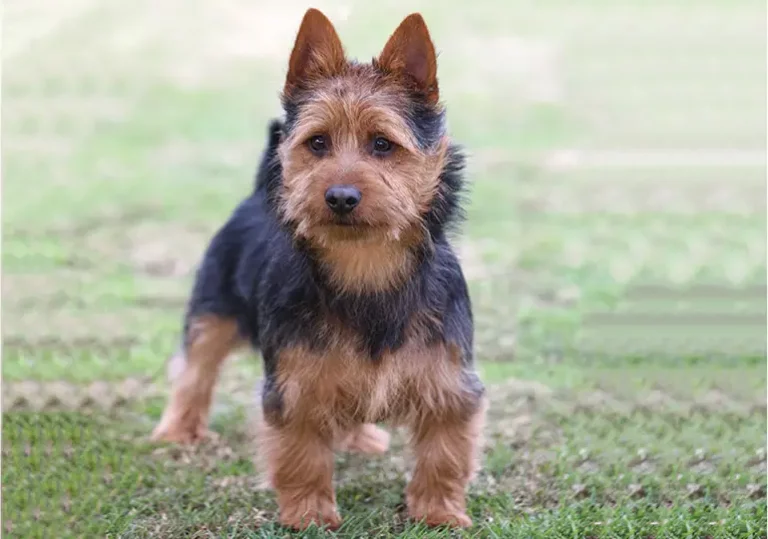
![How to Get Dog Poop & Urine Smell Out of House and Carpet? [8 Easy Solutions]](https://www.warmlypet.com/wp-content/uploads/2023/01/How-to-Get-Dog-Poop-Smell-Out-of-House.webp)
